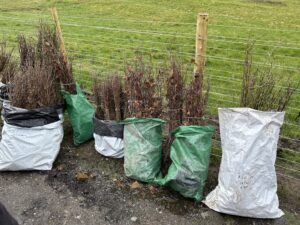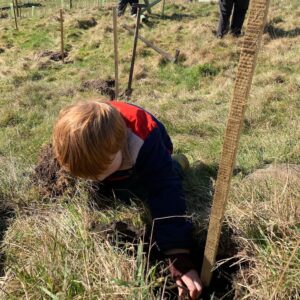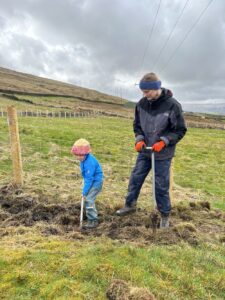Amy Liptrot and her oldest son join parents, geographers, the deskbound and the lonely to plant saplings on a South Pennine hillside.

I spend a rare day with just my older boy and take him — for the third time in his life — planting trees with local volunteer group Treesponsibility. It’s early Spring. Three minutes of sun, six of drizzle. A brief kestrel. We join a group of strangers on a hillside further up our valley, a mix of folk who have chosen to spend a damp weekend digging: parents, geographers, the deskbound, the lonely.
We are given work gloves, a narrow shovel and bags of saplings or ‘whips’: hazel, hawthorn, field maple, rowan and — controversially — beech. We are shown a newly fenced off and de-turfed strip where we will be planting a new hedge. Because of the fence, we don’t require the plastic protective tubes we’d used previously, making the work faster: Dig a hole, drop in the whip and press the earth around firmly. My boy works immediately down on his knees, digging with his hands. He alternates these bursts of energy with moaning and asking for biscuits. We look at some of the saplings we planted last year, some now peeking above their tubes and budding.

Treesponsibility has been running for 25 years, pre-dating the current Government tree planting drive. Its aims have been to plant new woodland and reforest to improve biodiversity, capture carbon and — particularly meaningful in this area — to reduce flooding. Since the Boxing Day floods of 2015, with the cooperation of local farmers and landowners, its volunteers have planted 50,000 trees.
Today the ground is muddy and it’s not as idyllic as last year when we planted alder, cherry, hazel, hawthorn and lime on a sunny day when I heard my first skylarks and curlews of the year. My kid, then 4, made it his job to run and fetch the whips and other items, becoming site delivery boy. Then he and his little friend tumbled to the bottom of the hill together. We stopped for tea from flasks and then for a shared lunch of soup, curry and bread sitting warmed outside.
Maybe it’s because of my farming childhood — with haymaking, sheep shearing and peat cutting — but spending time in communal outdoor work, with the kids playing around, feels like the right way to live, like communities of the past and maybe those of the future too.

Of course there are issues and complexities with tree planting: long-term management needs to be planned and the best use of land considered. Some people dislike the use of plastic tubes and think that meadows are equally as important as dense woodland. But I feel being part of carefully considered planting is a positive thing to do here in the South Pennines, where the hillsides are often overgrazed.
Most of the time l flail and despair — 95% of species rich grassland has has been lost in the UK, microplastics have been found in breastmilk — but today it felt absolutely right to be planting something good into the future, outdoors with kids and friends, and I wonder how our days can look more like this more often.